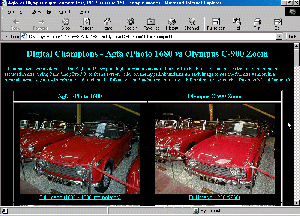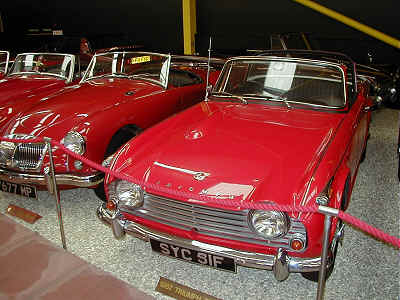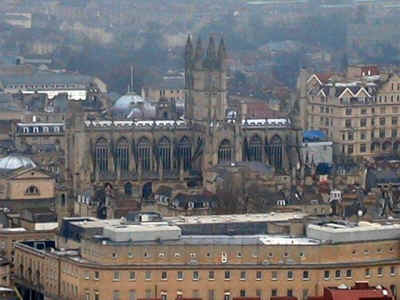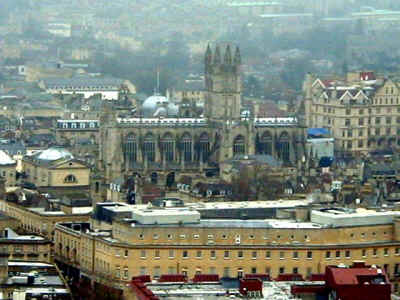
This article was published in PC Plus issue 151 (May 99), and is reproduced here for information purposes only. This is the original copy which was sent to the magazine, not the subbed version which appeared on the page. |
Digital camera head-to-head -
|

|
||||||||||||||||||||||||||||||||||||||||||||||||||||||||||||||||||||||||||||||||||||||||||||||
|
[BEGINS]
<head> <strap> <boxout for
intro page> <cam1.gif> See for
Yourself You'll find
sample images from the Agfa ePhot 1680 and Olympus C-900 Zoom on this
month's SuperCD. <body copy starts here>
For some time now photo giant Agfa has led the middle market with
its ePhoto 1280. Less attractive than cameras from rivals such as Kodak
and Nikon, it's made up for its aesthetic shortcomings with a high-grade
optical zoom lens and image quality that's in a different league from its
competitors, nearer to that of £1,000-plus professional units. Now Agfa
has upgraded the ePhoto 1280 to the ePhoto 1680, increasing its image
resolution and standard memory capacity.
Challenging the Agfa for top spot is an all-new camera from another
major player in the photographic industry, Olympus. Its C-900 Zoom has
comparable features to the Agfa, including that all-important zoom lens,
but with the significant advantage of an optical viewfinder to complement
its LCD screen. It's also a smaller and more conventionally-styled unit.
Most important of all though, its pictures have the same outstanding
clarity and fidelity that has, until now, kept the Agfa ahead of the
field.
Whether you're producing images for the Web, or for DTP, or just to
print out in place of conventional photographs, these cameras can do it
all, and do it so well that you really don't need a film-based
alternative. They're also priced within £50 of each other. The question
is, has Agfa held onto its lead, or is Olympus the new champion of the
middle division? <Agfa
body> Agfa ePhoto
1680 £704 (£599 +VAT) Agfa set the
benchmark for mid-price image quality with the ePhoto 1280 (reviewed in
issue 137), so its successor, the ePhoto 1680, comes with a strong
pedigree. It's basically the same camera, with Agfa's trademark
swivel-lens body, excellent 3 X optical zoom lens and large LCD display
panel, but now with a top resolution of 1600 X 1200 (via software
interpolation - see below), plus a 2 X digital zoom and new 'document'
image-capture mode.
The e1680 is big by current standards, and like its predecessor,
doesn't give a good first impression. The plastic casing is now silver
instead of black, but still looks and feels cheap. Although the lens
assembly swivels, it's crazily designed so that you can't tripod-mount it
with the LCD facing you for self-portraits. Our test machine had
previously been used, and had lost its lens cap - not surprising, since
the cap has a tendency to fall off and isn't secured to the camera.
As before though, once you start using the Agfa things improve
considerably. It has all the features you’d expect at this price level,
including fully automatic focus, exposure and white balance, a multi-mode
flash, a self-timer (with two settings), composite video output and macro
focus. It also has a few you
might not, such as an aperture-priority exposure option, three
distance-specific manual focus settings and ability to work with
slave-sensor external flash equipment.
The e1680 is a fairly easy camera to use. It's unusual these days
in having only a colour LCD (with no separate monochrome status panel),
but Agfa has made the best of this by locating all the camera's options in
an on-screen menu system, controlled by a single, IntelliMouse-Style
pushbutton/thumbwheel (cutely named the 'EasyPilot'). Some frame-by-frame
options (such as the self-timer) are buried inconveniently deep in the
menu hierarchy, but generally speaking it's a straightforward and
easily-understood system, in stark contrast to complexity of the Olympus
C-900's controls. The Agfa's zoom buttons also give much smoother and more
accurate control than the Olympus's.
Having the LCD panel as the sole viewfinder does, however, cause
significant problems. Despite two brightness settings, the screen is
difficult to see either in dark, pre-flash conditions or in bright
sunlight. And because you have to hold it around eight inches from your
face, it can be hard to keep the camera steady enough for zoomed-in shots.
An optical viewfinder would solve both problems, as well as alleviating
the Agfa's savage battery consumption (see below). However the 1680's
rather pointless swivel-body design precludes it, which seems a poor
trade-off.
The Agfa's real strength, as always, lies in its image quality. Not
only does the 35-105mm equivalent zoom lens provide crystal-clear focus
and good composition flexibility, but the 1680's light and colour
resolution is excellent too. Extreme sun-to-shadow levels of contrast are
handled easily, and the subject's original colours, whether natural or
wildly garish, are faithfully reproduced.
Like the previous 1280 model, the 1680's highest resolution images
are captured and stored at a lower pixel-rate (in this case 1280 X
960), then processed on the PC by Agfa's PhotoGenie software, which
'fills in' the extra pixels. We weren't impressed by the e-Photo 1280's
interpolation, but the new camera's results are much better - so
convincing, in fact, that you really can't tell which pixels have been
added. 1280 X 960 images (which match the CCD sensor's actual resolution)
are also superb, as are lower-res 640 X 480 images - something of a
breakthough, since digital cameras have traditionally been poor at
'trading down'. Even more surprisingly, the 2 X digital zoom produces
first-class results, something we didn't expect given the output we've
seen from other cameras. The 1680 is, however, noticeably slower than the
Olympus at compressing each image onto its 4MB SmartMedia memory card.
The unit comes with NiMH rechargeable batteries and a charger,
which is just as well as its power consumption is horrendous - we managed
just 27 images (half with flash) and downloads on a test set of
non-rechargeable alkalines. The LCD, on continuously during shooting, is
the problem, and a spare set of rechargeables would be advisable.
The Agfa's software bundle is much the same as its predecessor's,
which puts it back in first-class territory. The PhotoGenie
download/editing application is easy to use, and has a great 'quick fix'
option for correcting light and colour balance. You also get the wonderful
LivePicture PhotoVista, which stitches your images together into
360-degree panoramas.
Agfa's bulky LCD-only design is showing its age, but for £700 (£599
+ VAT) nothing comes closer to professional-quality digital photography.
With single-body models in the Agfa pipeline, look out for good discounts,
and enjoy the pictures. <Olympus body> Olympus C-900 Zoom £650 (£554 + VAT) In contrast to the bulky and unconventional Agfa 1680, the Olympus C-900 Zoom is very much a mainstream camera design. The same size and shape as Olympus' Mju 35mm film compact, its one-box body packs in a motorised 3X optical zoom lens (35-105mm equivalent) with integral cover, a pop-up flash unit, a 1.7-inch colour LCD panel, a separate optical viewfinder and a monochrome LCD status panel. Inside are the means to produce images in 1280 X 960 resolution (in three compression levels) with a memory-saving 640 X 480 option and a 2X digital zoom capability. The C-900's feature list is similar to the Agfa's, though it doesn't quite match it for photographic control. As well as the expected multi-mode flash, self-timer, macro focus and PALvideo output, it offers spot light metering, manual exposure compensation, a 2.5m fixed focus option and manual white balance control. There's no aperture priority option, but you do get sequence mode shooting (six 640 X 480 taken at half-second intervals), and an auto-advancing slide show for the video output. The C-900 can also connect directly to Olympus's' P300E printer. The camera's optical viewfinder shows why the Agfa needs one so badly. In 35mm compact tradition it zooms with the lens, allowing (fairly) accurate composition, and letting you keep the camera steady while seeing clearly in pre-flash and bright sunlight conditions. It also allows the power-hungry LCD to remain off during shooting, although this benefit is compromised by the C-900's reliance on LCD-based function menus (see below). Battery consumption is, nevertherless, markedly better than the Agfa's, at around 50 images per set of alkalines, although our test unit had a habit of switching off with a 'low power' warning after flash shots, even with half-full cells. Like the Agfa, the C-900 comes with a 4MB SmartMedia memory card, but unlike it, doesn't come with rechargeable batteries. The C-900's weak spot is, unexpectedly, its ease of use, or rather lack of it. The camera's back contains no less than nine buttons, eight of them with dual functions. Some of these do provide convenient, single-press access to key controls, such as self-timer and flash mode. However most of the camera's options are buried away in LCD-panel menus and accessed via bewildering multi-button sequences, and even after a week of regular use we still needed the manual's help to achieve quite basic tasks. This counter-intuitiveness extends to the major controls, such as the zoom lever, which is pulled backwards to zoom in, and pushed forwards to zoom out. Even switching the camera off is a fiddly, two-step process. Ultimately though it's results that count, and the C-900 has no problems on that front. Like the Agfa's, its focus is pin-sharp and its colours strikingly natural, and it handles high-contrast images extremely well. It lacks the Agfa's interpolated 1600 X 1200 mode, but its 1280 X 960 pictures are excellent, with few compression errors, and it also produces superb 640 X 480 images. Even the 2X digital zoom (which, like the Agfa's, works in 640 X 480 mode only) is a match for its rival's. The Olympus's wider maximum zoom angle gives it a small edge over the Agfa for indoor shooting, and its flash results are sometimes brighter. Against that, the Agfa proved better in really tricky focussing conditions, while the Olympus had a slight colour resolution problem in our flashlit red sports car shot. Overall, though, the two cameras are such a close match that it's hard to name a winner. Things aren't so equal on the software front. Olympus's Camedia download/editing application looks good at first, with an Explorer-like disk folder tree promising easy drag-and-drop downloading. However it turns out to be slow and awkward to use, with drag-and-drop sadly not supported. It does, nevertheless, perform all the basic cropping and colour/light correction functions. There's no PhotoVista, but buried away instead is Olympus's own panorama-stitching function. For some unexplained reason this only works with images taken in the C-900's special panorama mode (which look just like ordinary pictures), and unlike PhotoVista, doesn't come with a pan-and-zoom viewer application. The C-900 CD also contains a ponderous, and rather pointless, image album application. Gripes about controls and software don't seriously detract from the Olympus C-900's basic qualities. It's a superb camera, stylish and convenient, equipped with the combination of zoom lens and optical viewfinder that has been so notably absent from the mid-price range to date. Most important of all though, it produces truly exceptional results. Agfa no longer has the middleweight territory to itself. <conclusion> Agfa ePhoto 1680 vs Olympus C-900 Zoom - the PC Plus conclusion. This really is a tough one - two cameras priced within £50 of each other (less if you add a near-essential recharger and batteries to the Olympus), with very similar feature lists and virtually identical results. Both produce high-resolution images which wouldn't disgrace a full-colour bookstand magazine, plus 640 X 480 images that let Web authors save time and memory without sacrificing quality. For the real photo enthusiast aiming to produce printed output, the Agfa just has the edge. Its 1600 X 1200 interpolation system really works, and you can see the extra detail if you look closely. It also offers a greater degree of photographic control, and its colour fidelity is marginally more reliable in difficult conditions. For general-purpose shooting, however, it's a different story. The Olympus's detail functions may be harder to control than they should be, but the benefits of its zooming optical viewfinder easily outweigh that disadvantage, making it easier to use than the Agfa when you're actually taking a picture, and less likely to run out of power at a crucial moment. Add the facts that the Olympus's images are, for most practical purposes, just as good as the Agfa's, and that it's smaller, lighter and far more stylish, and there's little doubt which of the two cameras we'd rather take for a day's digital shooting. It's a close thing, but the Olympus C-900 Zoom is our new middleweight champion. <end of conclusion> <pix drop from last as required> <the famous red car shot> <AGFA01.JPG PLUS DETAIL PULLED OUT AND BLOW UP TO SHOW ACTUAL RESOLUTION>
<OLYMP01.JPG PLUS DETAIL PULLED OUT AND BLOW UP TO SHOW ACTUAL RESOLUTION>
<AGFA04.JPG>
<OLYMP04.JPG>
<facts and ratings>
[ENDS] (C) Paul Stephens 1999. All rights reserved.
|
||||||||||||||||||||||||||||||||||||||||||||||||||||||||||||||||||||||||||||||||||||||||||||||||





